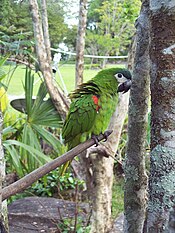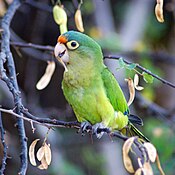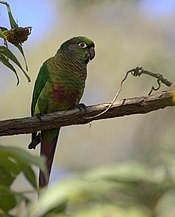Arini (tribe)
| Arini | |
|---|---|

| |
| Blue-and-yellow macaw | |
| Scientific classification | |
| Domain: | Eukaryota |
| Kingdom: | Animalia |
| Phylum: | Chordata |
| Class: | Aves |
| Order: | Psittaciformes |
| Family: | Psittacidae |
| Subfamily: | Arinae |
| Tribe: | Arini G. R. Gray, 1840 |
| Genera | |
|
| |
The Arini
hypothetical extinct species (see Extinct Caribbean macaws) have been described, native to the Caribbean area.[1][2]
Among the Arini are some of the rarest birds in the world, such as Spix's macaw, which is extinct in the wild – fewer than 100 specimens survive in captivity. It also contains the largest flighted parrot in the world, the hyacinth macaw. Some species, such as the blue-and-yellow macaw and sun conure are popular pet parrots.
Molecular studies have dated the divergence of the Arini tribe from the ancestral neotropical parrots to late in the Paleogene period about 30–35 million years ago.
Taxonomy
The Arini are one of three recognized clades in subfamily
Arinae of neotropical parrots in the family Psittacidae of Afrotropical and neotropical parrots, one of three families of true parrots
.
| Image | Genus | Living Species |
|---|---|---|
 |
Anodorhynchus Spix, 1824 |
|
 |
Cyanopsitta Bonaparte, 1854 |
|
 |
Ara Lacépède, 1799 |
|
 |
Orthopsittaca Ridgway, 1912 |
|
 |
Primolius Bonaparte, 1857 |
|
 |
Diopsittaca Ridgway, 1912 |
|
 |
Rhynchopsitta Bonaparte, 1854 |
|
 |
Ognorhynchus Bonaparte, 1857 |
|
 |
Guaruba Lesson, 1830 |
|
 |
Leptosittaca Berlepsch & Stolzmann, 1894 |
|
 |
Conuropsis † Salvadori, 1891 |
|
 |
Psittacara Vigors, 1825 |
|
 |
Aratinga Spix, 1824 |
|
 |
Eupsittula Bonaparte, 1853 |
|
 |
Thectocercus Vieillot, 1818 |
|
 |
Cyanoliseus Bonaparte, 1854 |
|
 |
Pyrrhura Bonaparte, 1856 |
|
 |
Enicognathus G.R. Gray, 1840 |
|
See also
- List of parrots
- List of macaws
- List of Aratinga parakeets
